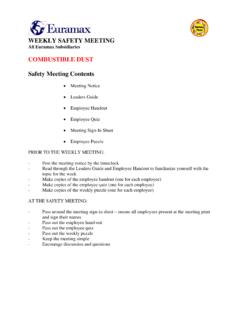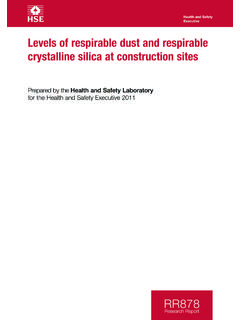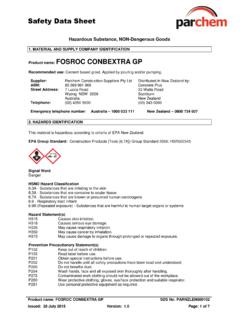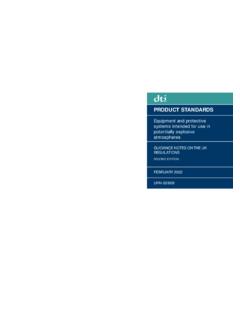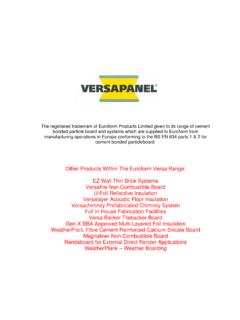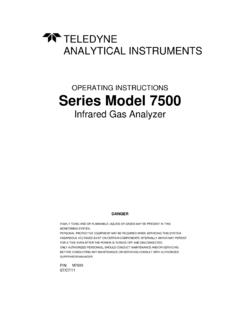Transcription of FLAMMABILITY OF PLASTICS & POLYMERS USED …
1 FLAMMABILITY OF PLASTICS & POLYMERS used AS ALTERNATE DAILY COVERS A SUMMARY OF TECHNICAL INFORMATION FROM THE PUBLIC DOMAIN Compiled and Edited by Paul A. Kittle, Rusmar Incorporated West Chester, PA April, 1993 TABLE OF CONTENTS EXECUTIVE SUMMARY INTRODUCTION FLAMMABILITY CONSIDERATIONS General Rate of Burning MEASURING AND CONTROLLING HAZARDS General Liquids Solids FLAME RESISTANT TREATMENTS FIRE BEHAVIOR OF SOLIDS SPECIAL FIRE BEHAVIOR PROBLEMS Ignitability and Rate of Burning Smoke Produced Toxic Gases Flaming Drips Deviation from Test Results FIRE TESTS FOR PLASTICS / POLYMERS FIGHTING FIRES IN PLASTICS / POLYMERS HEATS OF COMBUSTION ASTM E1354 CONE
2 CALORIMETER EVALUATIONS STANDARDS AND TARPAULINS/GEOTEXTILES CONCLUSIONS REFERENCES EXECUTIVE SUMMARY The information contained in this report has been collected from documents previously presented in the public domain. The main sources include the National Fire Protection Association, American Society for Testing Materials, Underwriters Laboratories, and other references cited therein. The main conclusions are: RCRA Subtitle D alternate daily cover regulations require control of disease vectors, fires, odors, blowing litter, and scavenging. The ASTM E1354 Cone Calorimeter evaluation procedure has shown all the common tarpaulins/geotextiles to be flammable and therefore they should be considered unacceptable for daily cover. In order of increasing Time to Ignition, the results of the ASTM E1354 Cone Calorimeter evaluation are: Cormier RPVC, 24 seconds; Cardboard, 34 seconds; Sanicover, 42 seconds; Griffolyn, 43 seconds; Fabrisoil, 44 seconds; Typar, 52 seconds; Air Space Saver, 77 seconds; Plywood, 151 seconds; Plexiglass, 156 seconds; Red Oak, 266 seconds; and Dry Wall, infinite (non-combustible).
3 ASTM E1354 CONE CALORIMETER TEST RESULTS MATERIAL IGN TIME (SECS) CORMIER RPVC 24 CARDBOARD 34 SANICOVER 42 GRIFFOLYN 43 FABRISOIL 44 TYPAR 52 AIR SPACE SAVER 77 PLYWOOD 151 PLEXIGLASS 156 RED OAK
4 266 DRY WALL INFINITE The Heats of Combustion of the commonly used tarpaulins/geotextiles are equivalent to coal, coke, wood, and straw, and only slightly less than that of jet fuel, fuel oil, and gasoline. HEATS OF COMBUSTION OF REPRESENTATIVE MATERIALS COMMON PLASTICS (2,3,4,5) Polyethylene MJ/Kg Polypropylene MJ/Kg Polystyrene MJ/Kg Polyvinyl Chloride MJ/Kg Urea Formaldehyde Foam MJ/Kg Unsaturated Polyester MJ/Kg COMMON TARPAULINS/GEOTEXTILES (8) Cormier RPVC MJ/Kg Griffolyn MJ/Kg Sanicover MJ/Kg Air Space Saver MJ/Kg Fabrisoil MJ/Kg Typar MJ/Kg OTHER COMMON MATERIALS (2,3,4,5)
5 Charcoal MJ/Kg Coal, Anthracite MJ/Kg Coal, Bituminous MJ/Kg Coke MJ/Kg Fuel Oil, #1 MJ/Kg Gasoline MJ/Kg Jet Fuel, JP-4 MJ/Kg Lignite MJ/Kg Paper, Newsprint MJ/Kg Straw MJ/Kg Wood, Dry, Average MJ/Kg Organic materials, in general, are excellent fuels. PLASTICS are classified as ordinary combustibles. Hydrocarbons produce twice the heat per pound as do cellulosics. PLASTICS are similar to most ordinary combustibles, such as wood, leather, wool, silk, etc. in that they are capable of thermal degradation into volatile and gaseous products of combustion.
6 According to the NFPA, the lack of stability of PLASTICS under high temperature conditions and inherent combustibility, have eliminated the use of PLASTICS for applications where a fire resistance rating is a requirement. It is most convenient to think of hazard control in terms of controlling first the likelihood of ignition, second the control or containment of the fire spread, and third management of the fire impact. It is important to recognize that claims for flame resistance have little meaning beyond the test method which was used to evaluate fire performance. The most desirable tests, from the standpoint of fire protection, are those that are suitable for all products for a particular application and that treat all products equally. Separate tests for PLASTICS , which do not allow comparison of the fire behavior under like test conditions, are undesirable.
7 The measurement of the imposed radiant flux is important in predicting fire hazards. The desirable standardized testing procedure is the ASTM E1354, Standard Test Method for Heat and Visible Smoke Release Rates for Materials and Products, Using an Oxygen Consumption Calorimeter. INTRODUCTION - The RCRA Subtitle D regulations - Criteria For Municipal Solid Waste Landfills (1) become effective on October 9, 1993. Of specific interest is paragraph , Cover Material Requirements, which state: (a) Except as provided in paragraph (b) of this section, the owners or operators of all MSWLF units must cover disposed solid waste with six inches of earthen material at the end of each operating day, or at more frequent intervals, if necessary, to control disease vectors, fires, odors, blowing litter, and scavenging.
8 (b) Alternative materials of an alternative thickness (other than at least six inches of earthen material) may be approved by the Director of an approved State if the owner or operator demonstrates that the alternative material and thickness control disease vectors, fires, odors, blowing litter, and scavenging without presenting a threat to human health and the environment. (c) The Director of an approved State may grant a temporary waiver from the requirement of paragraph (a) and (b) of this section if the owner or operator demonstrates that there are extreme seasonal climatic conditions that make meeting such requirements impractical. In some segments of the solid waste disposal industry these pending rules are being overlooked in that polyethylene, polypropylene, and other "plastic" tarpaulins/geotextiles are being used as daily cover, even though it is clear that these materials are generally flammable.
9 It is the object of this document to summarize information on the flammable characteristics of polyethylene, polypropylene, and similar " PLASTICS ". FLAMMABILITY CONSIDERATIONS - General Any discussion of the fire hazards of materials must center upon those materials which are organically derived, , those which are based on carbon. The simplest organic compounds are common fuels, as well as being building blocks for more complex materials. Organic liquids are fuels, solvents, and chemical intermediates. However, the largest variety of materials are organic solids. They include everything from specific compounds, such as aspirin, to common, but complex, everyday materials like wood, paper, textiles, and PLASTICS . All of these materials have carbon as their principal constituent; almost all contain hydrogen; and many contain oxygen, nitrogen, and other elements in varying amounts.
10 Most organic materials are excellent fuels. The common products of combustion are water and carbon dioxide (2,3). Solid organic materials fall into two broad classes: hydrocarbon-based and cellulose-based. The former are derivatives of the unoxidized hydrocarbon building blocks, - CH2-, or -CH- (like polyethylene and polypropylene, for instance).The latter are based on a partly oxidized carbon unit: -CH(OH)- (like wood, paper, and cardboard, for instance). Cellulose-based material, as it occurs in its natural state, could be considered already partially burned (oxidized). When the two classes, hydrocarbons and cellulosics, are burned to carbon dioxide and water, they consume different amounts of oxygen and produce different amounts of heat. For each equivalent of combustion product generated, the hydrocarbon-based materials consume fifty percent more oxygen.
